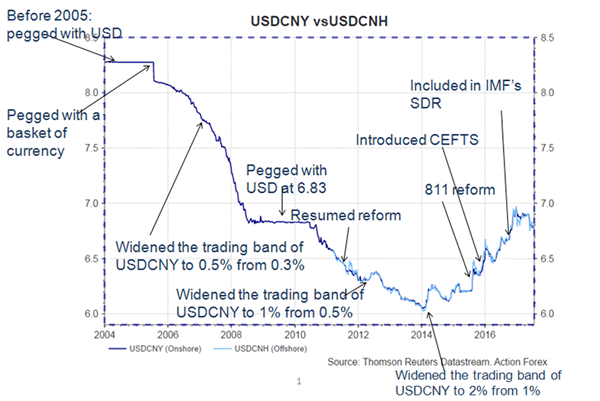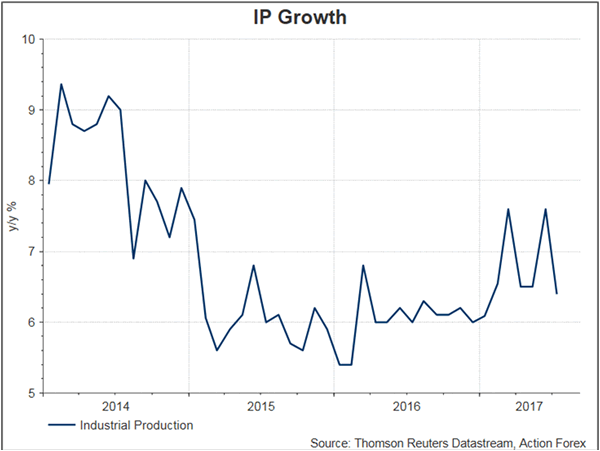USDCNY continues to recover after the pair slumped to the lowest level since December 2015 last Friday. The rebound, long-awaited as the broad-based USD weakness has caused the pair to decline over the past 4 months, is facilitated by PBOC’s announcement to remove the requirement for banks to hold the equivalent of 20% of clients’ FX forward positions as reserve for a year at 0% interest. For more than a decade, China has been implementing reforms in its currency, with the ultimate goal of achieving a floating exchange rate regime and convertibility for renminbi – a movement widely described as renminbi internationalization. However, this report seeks to explain that the government has only been moving back and forth, without making significant progress in transforming renminbi into a market-oriented exchange rate.

‘811-Reform’
On August 11, 2015, PBOC abruptly devaluated renminbi by -2%. On trading, CNY plunged -1.8% against USD, the biggest one-day decline since 1994. Besides, PBOC announced a new renminbi fixing mechanism, suggesting that the components used in setting that daily fixing rate include previous’ day’s close, FX demand and supply conditions and movement of major currencies. The market believed that the new mechanism had paved the way for renminibi to join IMF’s special drawing right (SDR). PBOC explained that it had to devaluate the currency as the midpoint had been diverging from the market rate for some time. However, we believe it was a means to rescue the slowdown in economic growth.



While inclusions of demand/supply conditions, as movement of major currencies in its calculation marked an effort to make renminbi more market-oriented, the surprising devaluation had dampened market confidence on the currency and evidenced that the currency remained under manipulation to the authority despite the rhetoric of market-orientation.
Panic selling of renminbi following the so-called ‘811-reform’ triggered the government adopt a series of capital control measures, including the abovementioned 20% FX reserve ratio effective from October 2015. Other capital control measures include strengthening supervision of foreign exchange purchases by foreign-held non-resident accounts (NRA), monitoring firms’ foreign exchange buying and tightening supervision of bank clients’ foreign exchange deals.
FX Reserve
Another prominent feature of China’s defense of renminibi depreciation is the massive selloff of FX reserve. US$630B of FX reserve was evaporated from Aug-2015 to Dec-2016. During the period, renminbi deprecated -10% against US dollar. PBOC aggressive selling sent FX reserve below US$ 3 trillion in January this year. There is no coincidence for the consecutive monthly rise in FX reserve and USDCNY’s decline since February.

CEFTS index
Remaining under pressure for the rest of 2015 and in 2016, renminbi’s weakness had been a result of concerns over further government devaluation in light of soft economic growth and a strong US dollar amidst rising expectations of Fed funds rate hike and reflation trade upon Donald Trump’s victory as the US president. Renminbi depreciation despite stringent capital control measures led to the ‘re-introduction’ of the CEFTS index in December 2016. Attempting to shift the market’s focus from renminbi vs US dollar to renminbi vs a basket of currencies, the government expanded the number of currencies in the CFETS basket to 24 from 13 in January 2017.
Counter-Cyclical Factor
Less than four months ago, the government indicated that it considered adding a ‘counter-cyclical factor’ in its fixing mechanism. As such, components in the daily fixing calculation would include previous day’s close+ changes in renminbi’s value against a basket of currencies+ counter cyclical factor. The authority explained that the new component would help prevent renminbi from being excessively affected by external volatility. Yet, it revealed no details about how the countercyclical factor would be computed or its weight in the new fixing mechanism. Introduction of the counter-cyclical factor evidenced that the government has chosen to control the currency movement, instead of increasing its transparency and taking a step forward in currency internationalization.
Indeed, we doubt whether the Chinese government is committed to achieving a floating exchange rate regime and convertibility for renminbi. Over the past decade, it has been moving one step forward and then several steps backward in its internationalization process. We are not hopeful that renminbi would become a global currency in the next decade, let alone a major reserve currency.














